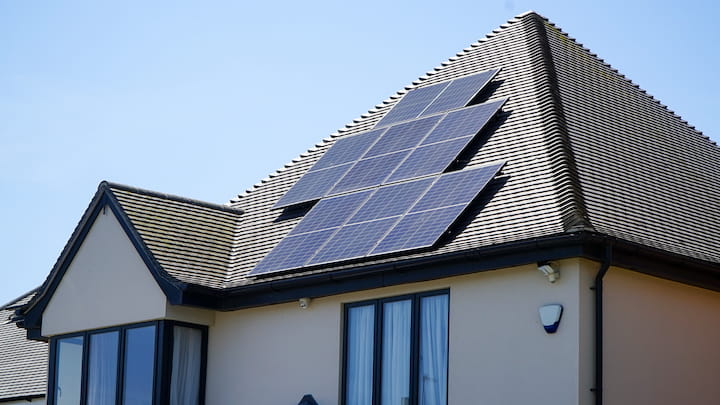In an era of rising energy costs, homeowners are increasingly looking for ways to improve energy efficiency in their homes. The roof, often overlooked in energy-saving strategies, plays a crucial role in regulating indoor temperatures and reducing heating and cooling costs. With the right roofing solutions, homeowners can create a comfortable, energy-efficient environment that helps lower utility bills and reduces environmental impact.
For those ready to make their homes more energy-efficient, working with a reputable roofing company like Kodiak Roofing can provide guidance on choosing and installing the most effective solutions. Here’s a look at how specific roofing choices can enhance energy efficiency, save on utility costs, and contribute to a greener home.
1. Cool Roofing: Reflective Materials for Lower Temperatures
Cool roofing is an energy-efficient option designed to reflect more sunlight and absorb less heat than traditional roofs. Cool roofs are often made from reflective materials, such as specialized coatings, white gravel, or light-colored roofing membranes. By keeping the roof surface cooler, they help reduce indoor temperatures and decrease the need for air conditioning.
Benefits of Cool Roofing
- Lower Cooling Costs: Reflecting sunlight helps cool down the roof’s surface, which in turn keeps indoor spaces cooler and reduces air conditioning usage.
- Extended Roof Lifespan: Reduced heat absorption lessens thermal stress on roofing materials, extending the life of the roof.
- Environmental Impact: By reducing energy consumption, cool roofs decrease greenhouse gas emissions, making them an eco-friendly choice.
Cool roofing materials are particularly effective in warm climates, where air conditioning accounts for a significant portion of energy usage.
2. Insulated Roofing: Boosting Energy Efficiency from the Inside
Roof insulation is essential for energy-efficient roofing, as it helps maintain consistent indoor temperatures by reducing heat transfer. Well-insulated roofs keep warm air inside during winter and block heat from entering in the summer, reducing the workload on heating and cooling systems.
Types of Roof Insulation
- Spray Foam Insulation: This option provides a strong, airtight seal that reduces air leakage and provides high R-value (resistance to heat transfer). It’s ideal for irregular roof shapes and hard-to-reach areas.
- Rigid Foam Insulation: Available in panels, rigid foam insulation offers high thermal resistance and is suitable for flat or low-slope roofs.
- Reflective Insulation: Reflective or radiant barrier insulation reduces heat gain by reflecting radiant heat away from the roof. This type is especially useful in hot climates.
Adding or upgrading insulation can significantly improve energy efficiency, making it easier to maintain a comfortable indoor environment regardless of outdoor temperatures.
3. Metal Roofing: A Durable, Reflective Option
Metal roofing is both durable and energy-efficient, making it a popular choice for homeowners focused on sustainability. Metal roofs reflect sunlight naturally, reducing heat absorption and keeping homes cooler. They are available in various styles and colors, making them suitable for both traditional and modern homes.
Advantages of Metal Roofing
- High Reflectivity: Metal reflects a substantial amount of sunlight, reducing heat gain and helping lower cooling costs.
- Long Lifespan: Metal roofing can last 40-70 years, reducing the environmental impact of frequent replacements.
- Recyclable Material: Most metal roofing materials are made from recycled content and can be fully recycled at the end of their life.
Metal roofs are ideal for homeowners seeking an eco-friendly, low-maintenance, and energy-efficient roofing option that also provides long-lasting protection.
4. Green Roofs: Nature’s Cooling System
Green roofs, or living roofs, incorporate vegetation and soil layers to create a natural insulation barrier. They not only improve energy efficiency but also support biodiversity and help manage stormwater. Green roofs are common in urban settings, where they reduce the urban heat island effect and create a more natural, pleasant environment.
Benefits of Green Roofs
- Enhanced Insulation: Soil and vegetation create a thermal barrier, reducing heat transfer and keeping indoor temperatures stable.
- Improved Air Quality: Plants absorb pollutants and release oxygen, enhancing air quality around the building.
- Stormwater Management: Green roofs absorb rainwater, reducing runoff and helping manage stormwater in urban areas.
Although green roofs require regular maintenance, they provide substantial energy savings, along with aesthetic and environmental benefits.
5. Solar Roofing: Harnessing Sunlight for Power
Solar roofing integrates solar panels directly into the roof structure, allowing homeowners to generate clean energy and reduce reliance on traditional power sources. By harnessing sunlight to produce electricity, solar roofing lowers utility bills and makes homes more energy independent.
Solar Roofing Options
- Solar Panels: Traditional solar panels can be installed on most types of roofs. They capture sunlight and convert it into electricity, which can power a portion of the home’s energy needs.
- Solar Shingles: Solar shingles blend seamlessly with conventional shingles, providing an aesthetic alternative to traditional solar panels while generating electricity.
Benefits of Solar Roofing
- Reduced Energy Costs: Solar roofing allows homeowners to offset electricity costs and, in some cases, earn credits for excess power generated.
- Increased Home Value: Solar roofing systems are considered a valuable asset that can increase property value.
- Sustainable Energy Source: Solar roofing reduces reliance on fossil fuels, lowering a home’s carbon footprint and supporting renewable energy use.
Solar roofing requires an initial investment, but it provides long-term savings and sustainability benefits that can make it worthwhile.
6. Roof Ventilation: Maintaining a Balanced Climate
Proper roof ventilation is a fundamental part of energy efficiency, as it helps regulate attic temperatures and reduces heat buildup. Good ventilation prevents hot air from getting trapped in the attic during summer and allows moisture to escape in winter, creating a balanced indoor climate.
Importance of Roof Ventilation
- Reduced Cooling Costs: Roof ventilation helps expel hot air from the attic, keeping the home cooler and reducing air conditioning needs.
- Preventing Moisture Buildup: In winter, proper ventilation prevents condensation, which can lead to mold and mildew growth.
- Extending Roof Life: By reducing thermal stress, ventilation protects roofing materials from premature aging and damage.
Ventilation is an essential aspect of energy-efficient roofing, enhancing both comfort and longevity.
7. Choosing Energy-Efficient Roofing Materials
While roofing technology and installation practices are key, the materials themselves significantly impact energy efficiency. Choosing the right material can make a substantial difference in energy consumption and the comfort of your home.
Energy-Efficient Roofing Materials
- Clay and Concrete Tiles: These tiles have a high thermal mass, which helps keep indoor temperatures stable by absorbing and releasing heat slowly. They’re ideal for warm climates and can reduce cooling costs.
- Asphalt Shingles with Cool Roof Coatings: Some asphalt shingles come with reflective coatings that improve their energy efficiency by reflecting solar heat.
- Slate Roofing: Known for its durability and natural insulation properties, slate is an excellent choice for energy efficiency, although it’s more commonly used in cooler climates.
Selecting an energy-efficient material, along with proper installation, maximizes energy savings and enhances the home’s comfort and value.
Conclusion: Embracing Energy-Efficient Roofing for a Greener Home
Energy-efficient roofing solutions offer numerous benefits, from reducing heating and cooling costs to supporting environmental sustainability. Homeowners have many options, from reflective cool roofing and well-insulated roofs to innovative green and solar roofs, each tailored to different climates, needs, and budgets. Working with a professional company like Kodiak Roofing ensures that your roofing installation maximizes energy efficiency and aligns with your specific goals.
By choosing Energy-efficient roofing solutions, such as reflective shingles and proper insulation, can significantly reduce heating and cooling costs while enhancing indoor comfort. These sustainable options not only benefit the environment but also offer long-term savings for homeowners. If you’re considering upgrading your roof with energy-efficient materials, view our service to explore professional solutions tailored to your needs in Spanish Fort, ensuring both quality and cost-effectiveness.


